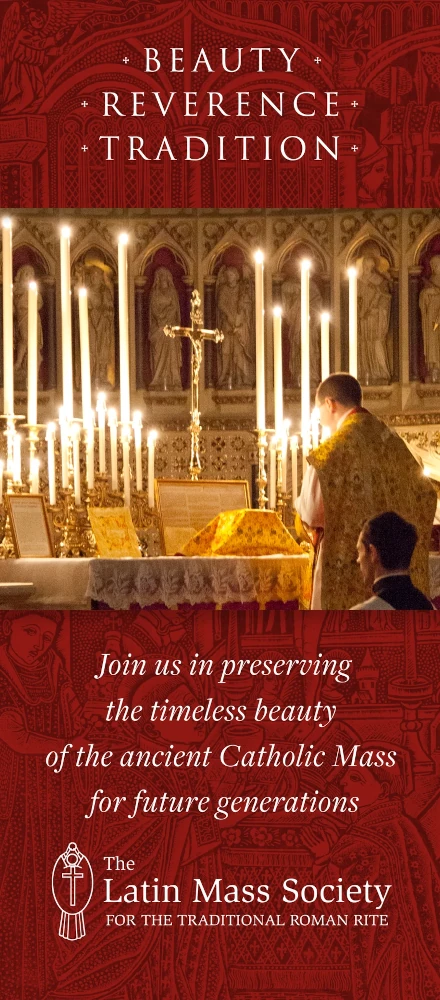Lost in Translation #119
The traditional Roman liturgy follows a reasonable pattern. After offering first the bread and then the wine (once it has been prepared), the priest offers himself:
In spíritu humilitátis et in ánimo contríto suscipiámur a te, Dómine: et sic fiat sacrificium nostrum in conspectu tuo hodie, ut pláceat tibi, Dómine Deus.Which I translate as:
In the spirit of humility and with a contrite heart may we be accepted by Thee, O Lord, and may our sacrifice be made in Thy sight this day, that it may please Thee, O Lord God.Like the Offerimus tibi, the number of the main verb is plural rather than singular, but the reason is not so clear. As we explained earlier, the priest and deacon at a Solemn High Mass say the Offerimus tibi together as they both touch the elevated base of the chalice. The “we” in the Offerimus tibi, then, refers to the priest and deacon. With the In spiritu humilitatis, on the other hand, the deacon does not say the prayer or bow with the priest, for he is giving the paten to the subdeacon and laying the purificator beside the corporal. [1]
Abbé Claude Barthe speculates that the plural is an instance of the “royal we,” [2] but the “royal we” is only used by popes and monarchs, and I do not see it used by a priest anywhere else in the liturgy. I instead contend that the priest has in mind the deacon and subdeacon as part of the “we” when he says this prayer, and for three reasons:
First, the deacon and subdeacon are more involved than anyone else in these acts of offering. During a Solemn High Mass (which, it must be recalled, is the normative form of the rite), lesser ministers such as the acolytes have less of a role to play in the Offertory preparations. The Angelus Press Missal claims that the priest has the assembled faithful in mind, which may be true; and there is certainly no harm in the laity using this possibility as part of their devotions during Mass. Nevertheless, I think it is more likely that, although the priest referred to them at the Suscipe Sancte Pater and will refer to them again at the Orate fratres, he is not doing so here.
Second, the deacon and subdeacon are physically near the priest as he says this prayer. It is as if the priest were saying, “My two closest assistants are busy right now, but on their behalf I pray that we are accepted by You.”
Third, the word of this prayer come from the prayer (Daniel 3, 26-45) spoken by Ananias when he and his companions Azarias and Misael were thrown into King Nebuchadnezzar II’s furnace to be burned alive. The three young men make the same number here as the priest, deacon, and subdeacon. In terms of strict logical necessity, this reason is perhaps a little weak, for one can easily and appropriately take a prayer intended for a given number of people and use it for a different number. Still, when the same number is involved, the relationship between the two is symbolically tightened. In this case, the resolution to the original story aligns well with the ultimate telos of this Offertory prayer. In the Book of Daniel, Nebuchadnezzar experiences a double astonishment: not only have the three youths been spared, but he sees as well “four men loose walking in the midst of the fire…and the form of the fourth is like the son of God.” (Dan. 3, 92) Is not the goal of the priest and his ministers during the Offertory and Canon to make present that fourth man, the Son of God?
An additional uncertainty is the meaning of the final petition, et sic fiat sacrifícium nostrum in conspectu tuo hodie, ut placeat tibi, Domine Deus, which is often translated along these lines: “And may the sacrifice which we offer this day in Thy sight be pleasing to Thee, O Lord God.” [3] I think the original biblical context, however, supports a different reading. The Douay Rheims translation of Daniel 3, 40 is “let our sacrifice be made in Thy sight this day, that it may please Thee.” In the first translation, we do not know when the sacrifice occurs (it could have just happened now in this act of self-offering), but we do know that it is happening today and in God’s sight. Our only worry is that it may not be pleasing to God, so we ask Him for that favor.
In the second translation, the sacrifice has not yet happened (in the case of the three youths, it will only happen when the king tries to turn them into a burnt holocaust) and the petitioners want the sacrifice, when it is made, to be made in God’s sight. The petitioners, in other words, want God to sanctify a sacrifice that is about to happen, which only God can do. And when God sanctifies a sacrifice, He recognizes His own in the sacrifice, so to speak, and is pleased by it. Pleasing God with sacrifice is the only reason for sacrificing in the first place.
_-_Fiery_furnace_01.jpg) |
| A mosaic of the three young men in the fiery furnace, early 11th century, in the monastery of St Luke (Hosios Lukas) in the Greek province of Boeotia. (Public domain image from Wikimedia Commons.) |
For “being accepted” in Daniel 3, 39, the Vulgate uses suscipiamur, and the In spiritu humilitatis faithfully follows this choice. Latin has several verbs to signify accepting or receiving. In the capio family alone, there are four. Capio means to grab, and it takes on different nuances depending on the prefix attached to it. Ad+capio or accipio literally means to take something to oneself; it is the origin of our work “accept.” Concipio is a combination of cum/con and capio. Cum/con can be used as an emphatic to amplify the power of the verb, but as the Latin preposition for “with,” it also implies a joint activity with someone or something else. Perhaps that is why concipio was the preferred way to express receiving fecundation—in other words, conception. Recipio, or re+capio means to take back and is the origin of our word “receive.”
But the Vulgate used the fourth variation. Suscipio is a contraction of sub+capio. Literally, the compound means to grab from underneath, as if reversing the fall of something by supporting it from below. But usually, helping someone who is falling down involves lifting them up. Suscipio thus came to mean “taking up” or “receiving.”
The connotation fits in well with the context. The priest is literally falling down when he utters these words, that is, he is bowed in humility, and his inner spirit, humble and contrite, is doing the same. He is also asking that the sacrifice be made in God’s sight, who is above us; thus, he is essentially asking God to take the sacrifice up to Him.
And there is an added connotation. Besides the generic meaning of “taking up,” suscipio has the specific meaning of taking up “a new-born child from the ground; hence, to acknowledge, recognize, bring up as one’s own.” [4] This act of “taking up” as a father’s way of accepting his paternity has surprising cross-cultural references. In ancient India, for example, the father sniffed the newborn babe of his wife, similar to that of an animal, as a way of ritually acknowledging this child as his own (long before the benefits of a DNA test). When we ask God to take Him up to ourselves, could it be that we are asking Him to be recognized as His adopted sons?
Finally, with the exception of the offering of wine, every offering during the Offertory uses the verb suscipio: the offering of the host during the Suscipe Sancte Pater, the offering of the priest, deacon, and subdeacon during the In spiritu humilitatis, the offering of the (entire) oblation during the Suscipe Sancte Trinitas, and the offering made by the congregation during the Suscipiat Dominus. The use of suscipio thus creates a chain that verbally binds together the different ceremonies of the Offertory into a single and unified oblation.
Notes
[1] See Adrian Fortescue, Ceremonies of the Roman Rite (Westminster, Maryland: Newman Press, 1953), 107.
[2] Forest of Symbols, 85.
[3] Angelus Press Missal (2004), 863. See St. Andrew Missal (1953), 902.
[4] “Suscipio,” Lewis and Short Latin Dictionary, 2.B.1.





















